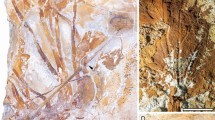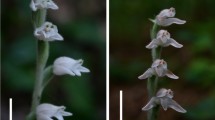Abstract
This article summarises an investigation of three selected species of fossil gymnosperms collected from the Upper Triassic Chinle Formation of the American southwest. Included here is an emended diagnosis of Lindleycladus arizonicus (Daugherty) comb. nov., a description of Elatocladus puercoensis sp. nov., and a redescription, based on new material, of the contentious plant fossil Dechellyia gormanii Ash. Also, the evidence (excisions and galls) of insect predation found on some of the leaves of the new specimens of D. gormanii is described and compared with that reported earlier on other fossil leaves in the Chinle Formation.







Similar content being viewed by others
References
Anderson, JM, Anderson HM (1989) Palaeoflora of southern Africa Molteno Formation (Triassic), Volume 2 Gymnosperms (excluding Dicroidium). Nat Bot Inst, Pretoria, p. 567
Anderson JM, Anderson HM, Cleal CJ (2007) Brief history of the gymnosperms: classification, phytogeography and ecology. Strelitzia 20
Ash SR (1970) Ferns from the Chinle Formation (Upper Triassic) in the Fort Wingate area, New Mexico. US Geol Sur Prof Pap 613D:1–40
Ash SR (1972a) Plant megafossils of the Chinle Formation. In: Breed WJ, Breed CS (eds) Investigations in the Triassic Chinle Formation. Bull Mus Northern Ariz 47:23–43
Ash SR (1972b) Late Triassic plants from the Chinle Formation in northeastern Arizona. Palaeontology 15:598–618
Ash SR (1972c) Marcouia gen. nov., a problematical plant from the Late Triassic of the southwestern USA. Palaeontology 15:423–429
Ash SR (1978) Plant megafossils. In: Ash, SRA (ed) Geology, paleontology and paleoecology of a Late Triassic lake, western New Mexico. Brig Young Univ Geol Stud 25(2):23–42
Ash SR (1989) A catalog of Upper Triassic plant megafossils of the western United States through 1988. In: Lucas SG, Hunt AP (eds) Dawn of the age of dinosaurs in the American southwest. New Mexico Mus Nat Hist, Albuquerque, pp 189–222
Ash SR (1991) A new pinnate cycad leaf from the Upper Triassic Chinle Formation of Arizona. Bot Gaz 152:123–131
Ash SR (1997) Evidence of arthropod-plant interactions in the Upper Triassic of the southwestern United States. Lethaia 29:237–248
Ash SR (1999) An Upper Triassic Sphenopteris showing evidence of insect predation from Petrified Forest National Park, Arizona. Int J Plant Sci 160:208–215
Ash SR (2001) New cycadophytes from the Upper Triassic Chinle Formation of the southwestern United States. PaleoBios 21:15–8
Ash SR (2005) A new Upper Triassic flora and associated invertebrate fossils from the basal beds of the Chinle Formation, near Cameron, Arizona. PaleoBios 25:17–34
Ash SR (2007) Order Dechellyiales Ash nov. In: Anderson JM, Anderson HM, Cleal CJ (eds) Brief history of the gymnosperms: classification, biodiversity, phytogeography and ecology. Strelitzia 20:207
Ash SR (2009) A Late Triassic flora and associated invertebrate fossils from the basal beds of the Chinle Formation in Dinnebito Wash, east-central Arizona, USA. Palaeontogr B 283:1–37
Ash SR (2011) Anomalous occurrence of the Gondwanan winged seed Fraxinopsis in a new Late Triassic (Norian) flora from west Texas, USA. Rev Palaeobot Palynol 166:94–106
Balick MJ, Furh DG, Cooper-Driver G (1978) Biochemical and evolutionary aspects of arthropod predation on ferns. Oecologia 35:55–89
Bazard DR, Butler RF (1991) Paleomagnatism of the Chinle and Kayenta Formations, New Mexico and Arizona. J Geophys Res 96(B6):9847–9871
Beckett, JM (1998) Conifers of the Triassic Chinle Formation of the South-Western U.S.A. PhD thesis, University of Manchester
Bock W (1969) The American Triassic flora and global correlations. Geol Center, Res Ser 3(4):1–340
Braun CFW (1843) Beiträge zur Urgeschichte der Pflanzen. In: Münster, GG, Beiträge zur Petrefacten-Kunde 6:1–46
Breed WJ (1972) Invertebrates of the Chinle Formation. In: Breed, CS, Breed, WJ (eds) Investigations in the Triassic Chinle Formation, Museum of Northern Ariz. Bull 47:19–22
Burnett GT (1835) Outlines of botany: including a general history of the vegetable kingdom, in which plants are arranged according to the system of natural affinities. J. Churchill, London
Carpenter FM (1992) Superclass Hexapoda. In: Kaesler RI (ed) Treatise on invertebrate paleontology, part R, Arthropoda, part 4, volumes 3 and 4. The Geological Society of America, Boulder
Cooley ME, Harsbarger JW, Akers JP, Hardt WF, Hicks ON (1969) Regional hydrogeology of the Navajo and Hopi Indian Reservations, Arizona, New Mexico and Utah. US Geol Sur Prof Pap 521A:1–61
Coulter JM (1912) History of gymnosperms. Popular Sci Monthly 80:197–203
Daugherty LH (1941) The Upper Triassic flora of Arizona. Carnegie Inst Washington DC Pub 526:1–108
Dickinson WR, Gehrels GF (2008) U-Pb ages of detrital zircons in relation to paleogeography. Triassic paleodrainage networks and sediment dispersal across southern Laurentia. J Sed Res 78:745–764
Emmons E (1856) Geological Report on the midland counties of North Carolina. Putnam, New York
Emmons E (1857) American geology, pt 6. Sprague, Albany
Fontaine WM (1883) Contributions to the knowledge of the older Mesozoic flora of Virginia. US Geol Surv Monogr 6:1–144
Halle TG (1913) The Mesozoic flora of Graham Land. In: Nordenskjöld, N (ed) Wissenschaftliche Ergebnisse der schwedischen Südpolar-Expedition 1901–1903 3 (14):1–123
Harris TM (1979) The Yorkshire Jurassic flora V, Coniferales. British Museum (Natural History), London
Irmis R, Mundil R (2008) New age constraints from the Chinle Formation revise global comparisons of Late Triassic vertebrate assemblages. J Vert Paleontol 28(supplement to n. 3):95A
Kirpotenko AP (1884) Outline of the natural classification of plants. Compiled after Eichler. L. N. Zhukovskaja, St. Petersburg
Labandeira CC (2006) Silurian to Triassic plant and hexapod clades and their associations: new data, a review, and interpretations. Arthropod Syst Phylogeny 64:53–94
Labandeira CC, Wilf P, Johnson KR, Marsh F (2007) Guide to insect (and other) damage types on compressed plant fossils, version 3.0. Smithsonian Inst Washington, DC.
Linnaeus C (1753) Species plantarum. Stockholm. 2 v.
Lucas SG (1993) The Chinle Group: revised stratigraphy and biochronology of Upper Triassic nonmarine strata in the western United States. In: Morales M (ed) Aspects of Mesozoic geology and paleontology of the Colorado Plateau. Mus Northern Ariz Bull 59:27–50
Martz JW, Parker WG (2010) Lithostratigraphy, sedimentology, and age model of the Upper Triassic Chinle Formation in Petrified Forest National Park, northeastern Arizona. In: Trendell A (ed) Paleosols and soil surface system analogs. Baylor University, Waco, pp 5–18
Miller IM, Hickey LJ (2010) The fossil flora of the Winthrop Formation (Albian-Early Cretaceous) of Washington state, USA. Part II: Pinophytina. Bull Peabody Mus Nat Hist 51:3–96
Newberry JS (1876) Geological report, in Report of the exploring expedition from Santa Fe, New Mexico, to the junction of the Grand and Green Rivers of the great Colorado of the west, in 1859, under the command of Capt. J. N. Macomb, Corps of Topographical Engineers: U.S. Army Engineers Rept. 9–118.
Pott C, Labandeira CC, Krings M, Kerp H (2008) Fossil insect eggs and ovipositional damage on Bennettitalean leaf cuticles from the Carnian (Upper Triassic) of Austria. J Paleontol 82:778–789
Pott C, McLoughlin S, Shunqin W, Friis EM (2012) Trichomes on the leaves of Anomozamites villosus sp. nov. (Bennettitales) from the Daohugou beds (Middle Jurassic), Inner Mongolia, China: Mechanical defence against herbivorous arthropods. Rev Palaeobot Palynol 169:48–60
Scott AC, Anderson JM, Anderson HM (2004) Evidence of plant–insect interactions in the Upper Triassic Molteno Formation of South Africa. J Geol Soc [London] 161:401–410
Sitgreaves L (1854) Diary. In: Sitgreaves L, et al. Report of an expedition down the Zuni and Colorado Rivers. US 32nd Cong., 2nd sess. Senate Exec Doc. 59, pp. 4–29.
Spamer EE (1989) A historic piece of petrified wood from the Triassic of Arizona. Mosasaur 4:149–152
Stewart JH, Poole FG, Wilson RF, Cadigan RA, Thordarson W, Albee HF (1972) Stratigraphy and origin of the Chinle Formation and related Upper Triassic strata in the Colorado Plateau region. US Geol Survey Prof Pap 690:1–336
Ward LF, Fontaine WM, Wanner A, Knowlton FH (1900) Status of the Mesozoic floras of the United States. First Paper: the older Mesozoic. US Geol Survey Ann Rept 20:213–430
Weber R (1985) La plantas fósiles de la Formación Santa Clara (Triásico Tardío, Sonora, México): Estsdo actual de las investigaciones. In: Weber, R (ed) Simposio sobre flores del Triásico Tardío su fitogeografia y paleoecologia. 3d Cong. Latinoamericano Paleo., Univ. Nal. Autón. México, Inst. Geología, Memoria, pp. 107–124.
Weber R, Zambrano-Garcia A, Amozurrutia-Sliva F (1980) Nuevas contribuciones al conocimiento de la Tafoflora de la Formación Santa Clara (Triásico Tardío) de Sonora. Univ Nal Autón México, Inst. Geología, Revisita 4:125–137
Wilson IF, Rocha VS (1949) Coal deposits of the Santa Clara district, near Tonichi, Sonora, México. US Geol Surv Bull 962-A:1–80
Acknowledgements
I am pleased to have the opportunity of contributing to this special issue honoring Han Van Konijnenburg-van Cittert. We first met on Prof. Harris’ annual collecting trip to the Yorkshire Jurassic in the spring of 1965. At that time, she was an undergraduate student at Utrecht and I was just finishing my PhD at Reading with Prof. Harris. In other words, we were both just starting out on our own palaeobotanical careers when we met. It has been quite gratifying to see how well she has progressed in the years that have followed our time slogging around in the mud at Hasty Bank and evading high tide at Cayton Bay. It was during this field trip that Han demonstrated her keen eye for fossils by collecting some small bits of rather scrappy material at the Scalby Ness plant bed that I probably would have ignored. Thankfully she did not, because they proved to be the remains of a small male cone containing pollen that she named Pityanthus scalbiensis way back in 1971. Han, judging by your past accomplishments and activities, I am sure that you will keep busy in the future, even if you have threatened to give up on palaeobotany. Good luck and god speed, dear friend, as the old saying goes. As for me, I am grateful to the various superintendents of Petrified Forest National Park who have permitted me to collect plant fossils there over the years, including most of those described here. The helpfulness extended to me by the other officials at the park is acknowledged with thanks. My field work in the park was supported in part by grants from the Petrified Forest Museum Association. I acknowledge with thanks the constructive comments and recommendations of Christian Pott (Stockholm) and Brian Axsmith (Mobile) who reviewed this manuscript and Conrad Labandeira (Washington, D.C.) for his discussions about the evidence of the interactions of insects and the Dechellyia gormanii leaves described here. Finally, I thank Mike Spilde, manager of the EPS/IOM Electron Facility at the University of New Mexico, for helping me obtain the SEM micrographs in Fig. 6.
Author information
Authors and Affiliations
Corresponding author
Additional information
This article is a contribution to the special issue “Green planet - 400 million years of terrestrial floras. Papers in honour of JHA van Konijnenburg van Cittert”.
Rights and permissions
About this article
Cite this article
Ash, S.R. Contributions to the Upper Triassic Chinle flora in the American southwest. Palaeobio Palaeoenv 94, 279–294 (2014). https://doi.org/10.1007/s12549-014-0150-3
Received:
Accepted:
Published:
Issue Date:
DOI: https://doi.org/10.1007/s12549-014-0150-3




